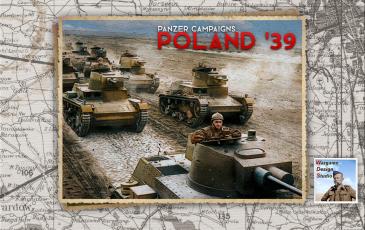0901_08_Slask - Allied AI - PzC 31 Poland '39

b59375da7db50f7a9280.jpg) 0 - 0 - 0
0 - 0 - 0
4f09d1569063283d124d.jpg)
| Rating: | 0 (0) |
| Games Played: | 0 |
| SM: | 4 |
| Turns: | 48 |
| Type: | Stock |
| First Side: | Axis (Poland-39) |
| Second Side: | Allies (Poland-39) |
Date: September 1st, 1939 - Size: Medium - Location: Silesia
Intended for play as Axis Human vs Allied AI or Head to Head
Scenario Briefing: Ceded from Germany to Poland in 1921, East Upper Silesia was home to a valuable coal mining industry and a significant German-speaking minority. The Polish government fully expected that Germany might one day try to reclaim this lost territory and undertook a fortification project in 1933, building more than 140 concrete bunkers in front of Katowice. These formidable Polish defenses were sure to deter a direct attack from the west.
The situation changed dramatically between October of 1938 and March of '39. With the annexation of the Sudetenland and the subsequent dissolution of Czechoslovakia, the Germans had effectively outflanked the Katowice fortifications. General Wilhelm List took full advantage of these territorial gains when planning his 14th Army's assault on Poland. List assigned the the Panzers and mountain troops of XVIII Army Corps to make his main effort, advancing out of Slovakia toward Myslenice while the XVII Corps moved against Biala-Bielsko and VIII Corps covered the Katowice fortifications. List hoped that his maneuver would not only force the Poles to cede Katowice, but that it would result in the total encirclement and annihilation of Army Krakow.
Like all Polish field army commanders, General Antoni Szylling of Army Krakow had insufficient resources to defend his assigned sector. Polish intelligence had an incomplete understanding of the German forces in Slovakia and consequently few troops were deployed on the Slovak border. The thinly spread ON and KOP detachments of the 1st Mountain Brigade could hardly hope to delay the two armored divisions advancing from the south, let alone stop them. Very soon Szylling and his troops would be confronted with a decision: retreat or perish.
Recommended Rules: (Default)
Alternative Assault Resolution, Artillery Set Up, Recon Spotting, Virtual Supply Trucks, Optional Surrender, Low Visibility Air Effects, Quality Fatigue Modifier, Counter Battery Fire, Night Fatigue, Programmed Weather.
Additionally, Delayed Disruption Reporting will provide a more challenging experience for the attacking player.
Design Notes:
1. The low-value objectives placed near the border expire early in the scenario. These may be very difficult to capture before they expire and are not required for a German victory. Their purpose is to penalize the Polish player somewhat should he choose to abandon the border immediately.
2. This scenario uses conditional reinforcements. The arrival of some Polish reinforcements are tied to control of certain objective hexes.
Intended for play as Axis Human vs Allied AI or Head to Head
Scenario Briefing: Ceded from Germany to Poland in 1921, East Upper Silesia was home to a valuable coal mining industry and a significant German-speaking minority. The Polish government fully expected that Germany might one day try to reclaim this lost territory and undertook a fortification project in 1933, building more than 140 concrete bunkers in front of Katowice. These formidable Polish defenses were sure to deter a direct attack from the west.
The situation changed dramatically between October of 1938 and March of '39. With the annexation of the Sudetenland and the subsequent dissolution of Czechoslovakia, the Germans had effectively outflanked the Katowice fortifications. General Wilhelm List took full advantage of these territorial gains when planning his 14th Army's assault on Poland. List assigned the the Panzers and mountain troops of XVIII Army Corps to make his main effort, advancing out of Slovakia toward Myslenice while the XVII Corps moved against Biala-Bielsko and VIII Corps covered the Katowice fortifications. List hoped that his maneuver would not only force the Poles to cede Katowice, but that it would result in the total encirclement and annihilation of Army Krakow.
Like all Polish field army commanders, General Antoni Szylling of Army Krakow had insufficient resources to defend his assigned sector. Polish intelligence had an incomplete understanding of the German forces in Slovakia and consequently few troops were deployed on the Slovak border. The thinly spread ON and KOP detachments of the 1st Mountain Brigade could hardly hope to delay the two armored divisions advancing from the south, let alone stop them. Very soon Szylling and his troops would be confronted with a decision: retreat or perish.
Recommended Rules: (Default)
Alternative Assault Resolution, Artillery Set Up, Recon Spotting, Virtual Supply Trucks, Optional Surrender, Low Visibility Air Effects, Quality Fatigue Modifier, Counter Battery Fire, Night Fatigue, Programmed Weather.
Additionally, Delayed Disruption Reporting will provide a more challenging experience for the attacking player.
Design Notes:
1. The low-value objectives placed near the border expire early in the scenario. These may be very difficult to capture before they expire and are not required for a German victory. Their purpose is to penalize the Polish player somewhat should he choose to abandon the border immediately.
2. This scenario uses conditional reinforcements. The arrival of some Polish reinforcements are tied to control of certain objective hexes.





















